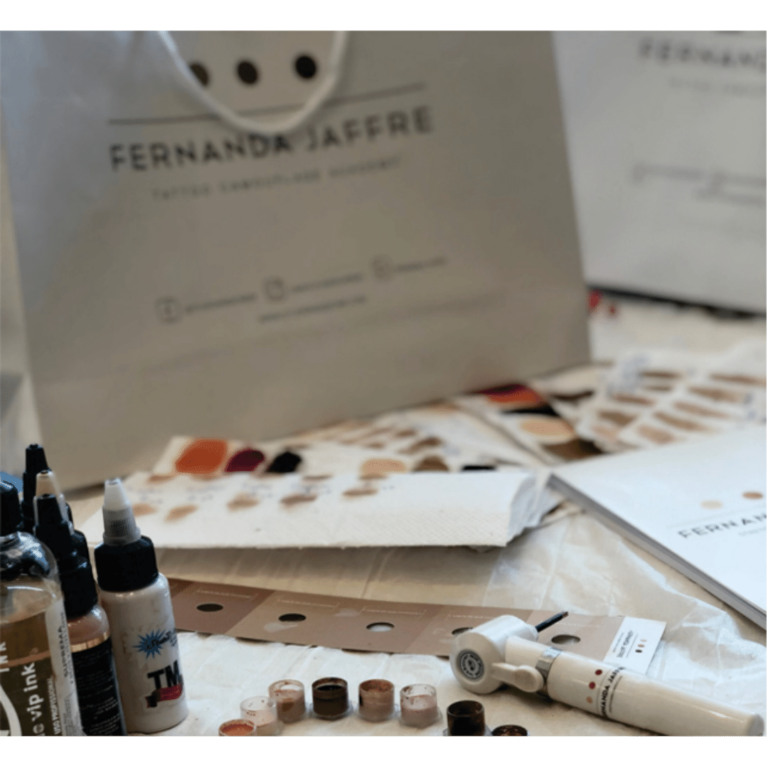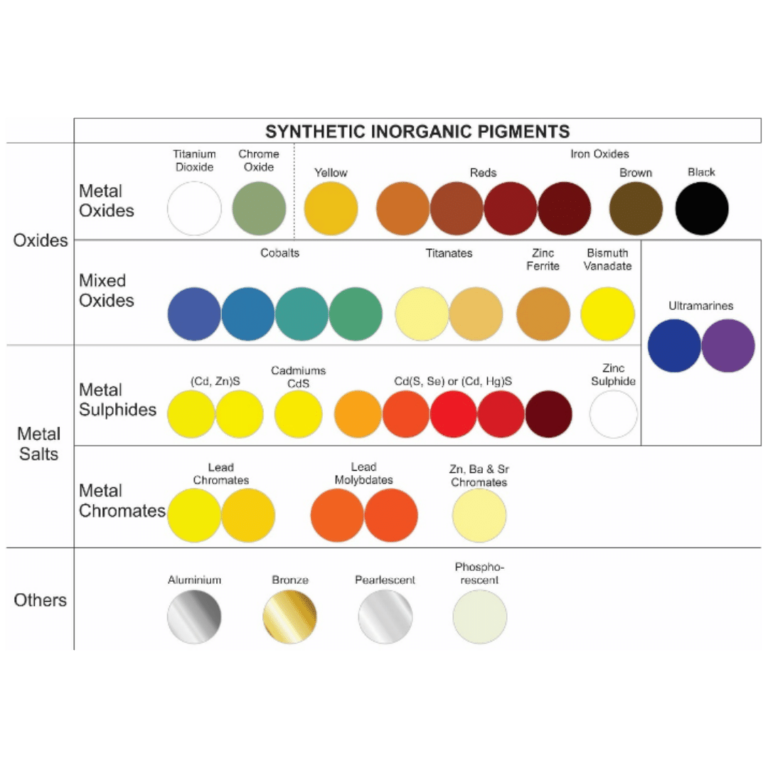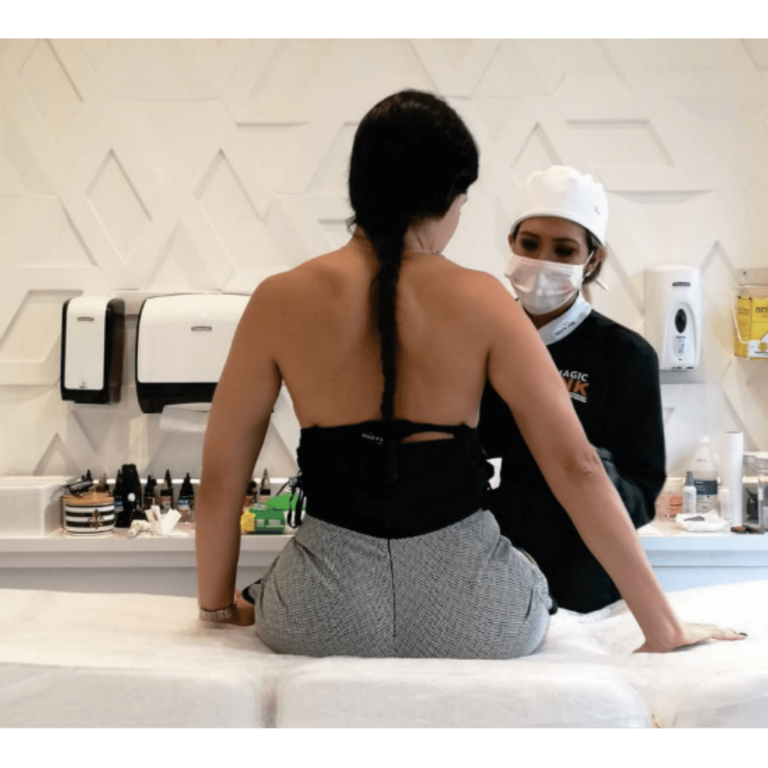If you are like me, so far you’ve only heard about the Brazilian wax and how much it hurt. Yet, have you heard about the Brazilian scar camouflage? Sure, you might be aware of its existence too. Yet did you know that with this innovative and magical technique it’s possible to cover up scars, stretch marks, vitiligo, and stains? Yes, you read it right…
But then again what is this so famous Brazilian camouflage technique about? How does it work? Do we use pigment tattoo for scars? If so, what kind of scar camouflage tattoo ink is used? To find out this and more, keep on reading.
Firstly, I must highlight that the Brazilian scar camouflage is a tattooing technique. Thus, the ink and all the other ingredients in this procedure are for tattooing.
To put it shortly, the Brazilian camouflage tattoo is an art. The tattoo artist specializing in scar cover up has to develop a customized mix of colors. This mix has to be as close as possible to the color of your skin using pigment tattoo for scars. Then, the artist will cover up your scar imitating the characteristics of your skin and carefully following your body’s fibers. When done correctly, the final result will have a very clean and uniformed aspect. You might even end up forgetting that you ever had a scar at all!
Even though, the ink is injected in the dermis in both methods, an artistic tattoo and a Brazilian camouflage tattoo use very different methods. Opposed to the tattoo artist specializing in scar cover up, an artistic tattoo emphases on the vibration on the skin and its highlights.
The medical tattoo artist applies a different technique. The tattoo artist specializing in scar cover up will be careful to use less vibration in order to damage less your skin. He/she makes the pigments that are typically used in artistic tattoos vibrate less on the skin. Making the stretch mark and scar coverage have a natural aspect. The final result being very discrete.
As mentioned above, the pigment tattoo for scars used in the Brazilian camouflage tattoo is the same used for artistic tattooing. That is to say, the tattoo artist specializing in scar cover up uses inorganic inks. This kind of ink is made to settle down on our dermis. Hence, avoiding complications like the color changing through time.
Some professional practitioners work with the micropigmentation technique though. The micropigmentation specialist applies the pigments to the epidermis. Yet, differently from our brazilian scar camouflage, this will only provide temporary results.
You might have heard of someone doing a micropigmentation to cover up their scar. This technique not only provides a momentary result but you also have to be extremely cautious of getting sun tanned. Also, you have to be wary of some micropigmentation specialists’ that uses organic pigments and applies them to the dermis.
The problem being that organic inks are specially prepared for micropigmentation. This means that they are made to fade away as time goes by. So, when they are used a as permanent tattoo, the result will tend to change colors. Since there was an inappropriate chemical interaction.
Once the organic ink settles in the dermis, most of the time, the result will be an unaesthetic camouflage. That is one of the reasons why you might come across greenish, bluish, orangey eyebrows.
The tattoo artist specializing in scar cover up, uses pigment tattoo for scars. Opposed to a micropigmentation specialist as foretold. This is why we use inorganic ink in our studio during the Brazilian scar camouflage. This technique must also come with an appropriate use of instruments. When applied together with the right knowledge, you’ll get natural and long-lasting results.
You’ll be happy to know what follows. It is possible to camouflage approximately 90% of skin types with our technique. Yet, the tattoo artist specializing in scar cover up has to study each skin type thoroughly.
Each formula must be personalized and adapted to the skin tone. ‘’It is of upmost importance that we analyze each detail of the skin. Since we must prepare the most efficient method of application and formula. The ANVISA and FDA approved all the inks we use ”, says Fernanda Jaffré, the owner of the Tattoo Camouflage Academy.
This is to say that each formula has to be especially prepared for each client. Not having an already made formula to each skin type like some tattoo artist specializing in scar cover up may have is essential.
Colorimetry applied to scar camouflage technique by Fernanda Jaffre

Figure 1: All materials used in the Brazilian scar camouflage procedure. They must be approved by the health and human services department of your city / country.
Many factors must be considered while preparing the formula to get fabulous results. Fernanda Jaffre is an instructor and specialist in colorimetry. She is known worldwide as a master in color blending! She teaches professionals who wish to specialize in colorimetry all over the world. While applying this knowledge to the Brazilian camouflage tattoo technique.
You must carefully choose the professional tattoo practitioner with whom you will perform your cover up. Since they must be adequately trained! The tattoo artist specializing in scar cover up must have an in-depth knowledge of colorimetry. How they react through inorganic pigments. Which is, as mentioned, different from colorimetry applied to micropigmentation.
“The knowledge of color mixing is vital for tattoo artist specializing in scar cover up. But a great number of camouflage artist don’t reflect on the chemicals that are behind the ink colors. Yet, each ink is made from a different chemical. We are speaking about chemical elements that react in a particular manner! They have very distinct molecular weight and specific intrinsic characteristics. These concepts appear far from the tattooing world and the Brazilian camouflage tattoo. Yet, they are essential! Since they will directly influence the results at first. And specially, after time goes by.”, says Fernanda Jaffre, a scholar in biomedicine.
In other words, how do tattoos relate to chemistry? Well, the chemical directly impacts the visibility and stability of the ink. These factors are intimately linked to the immunological system of the individual. So, they will be expressed in the result of the Brazilian scar camouflage.
The majority of inorganic inks are shinier and last longer than organic pigments. Organic pigments are made from natural sources that have been used for centuries. But nowadays most pigments used in industry are inorganic or synthetic organics.
Stretch marks and scar camouflage tattoo technique. Study by Fernanda Jaffre on colors of synthetic inorganic pigments

Figure 2: Study of color tables of synthetic inorganic pigments in the Brazilian stretch marks camouflage tattoo.
Synthetic organic pigments are derived from coal tars and other petrochemical products. Inorganic inks are produced by relatively simple chemical reactions, mainly oxidation. Yet, some can be naturally found in the soil.
Inorganic inks include opaque white pigments to supply opacity and lighten other colors. The most crucial element in this type of pigment is the titanium dioxide. Other white pigments are added to the inks to cut costs or improve their properties. This class includes calcium carbonate, calcium sulfate, diatom silica (remainders of marine organisms), and China clays.
Black pigments are mainly created from carbon particles. Carbon black, for example, is used to darken inks. Iron oxide, soils, produce ochers (brownish-yellowish colors), sienna colors (brownish-orangey), and umber (brownish colors).
Certain chromium compounds are used to supply chrome yellows, oranges, and greens. While various cadmium compounds produce bright yellows, oranges, and reds. Iron or Prussian blue and ultramarine blue are the most widely used blue pigments, and they come from inorganic sources. Certainly, this may seem complicated. But the tattoo artist specializing in scar cover up must take all this into account. While preparing the formula for your skin tone!
Before performing the stretch mark camouflage procedure. Master specialist Fernanda Jaffre analyzing the client’s skin tone

Figure 2: Master Fernanda Jaffre analyzing the client’s skin tone.
In view of her experience, the specialist Fernanda Jaffre knows that you will have better results by using inorganic pigments. As foretold, this is due to their properties. This is why the tattoo artist specializing in scar cover up needs to take the composition of the pigment tattoo for scars into account.
Besides, it is imperative to explain to your clients that Brazilian scar camouflage is an art. Keeping in mind that, inks age and act differently on the skin. The behavior of inks can vary from individual to individual. Which is also based on their durability.
Another important key is how the individual’s organism metabolizes the pigment. Yet, this matter will have to be studied thoroughly once the procedure is done.
Thankfully, you can seek a specialist professional practitioner in Brazilian camouflage tattoo in case you want to camouflage your scar. Refreshing your camouflage after aging or once your skin your tonality change! So it can adapt to the new condition displayed. Thus, you can have once again a natural and uniformed look!
Fernanda Jaffre – From Brazil, world-renown Brazilian scar camouflage tattoo pioneer instructor.